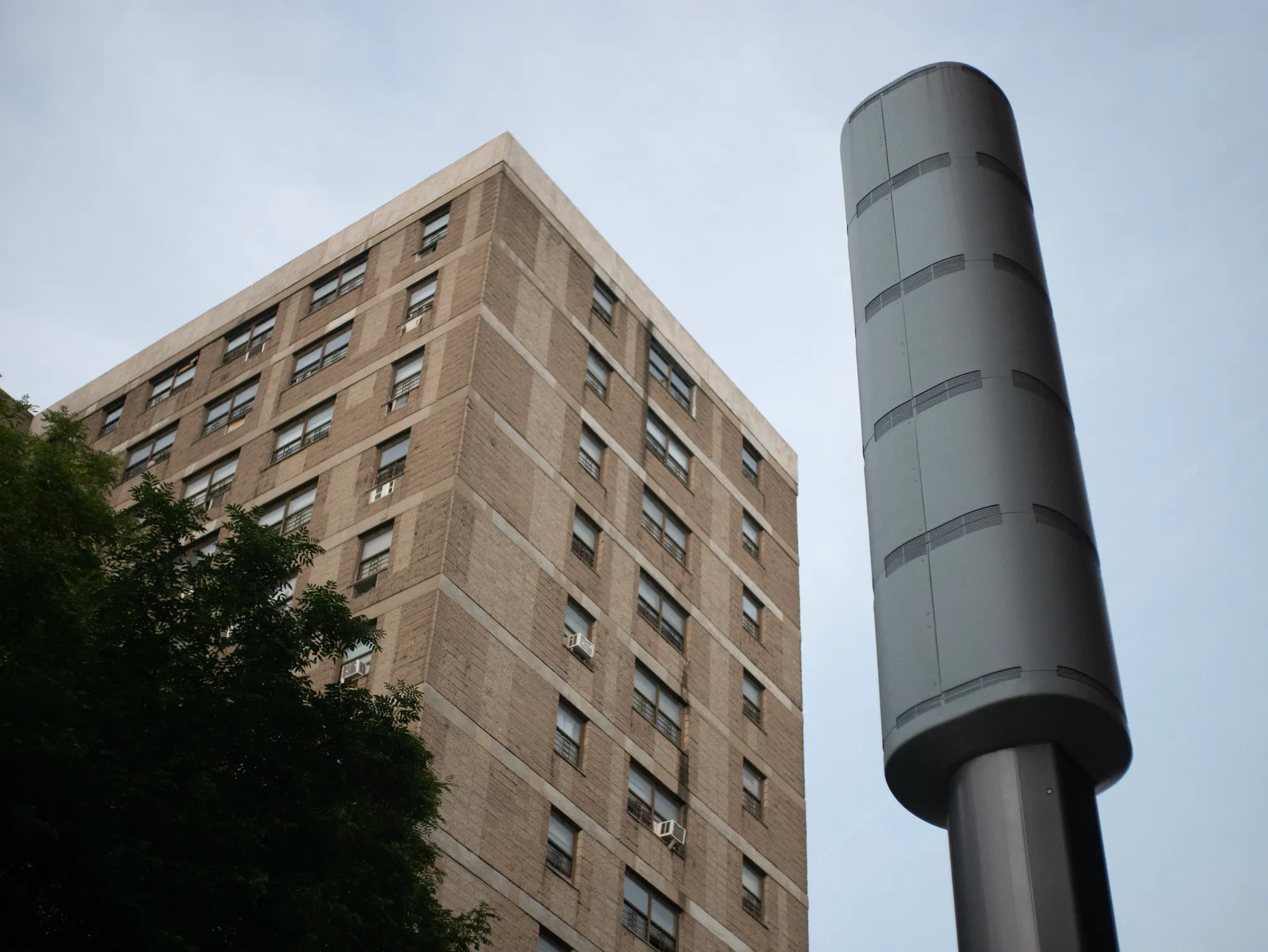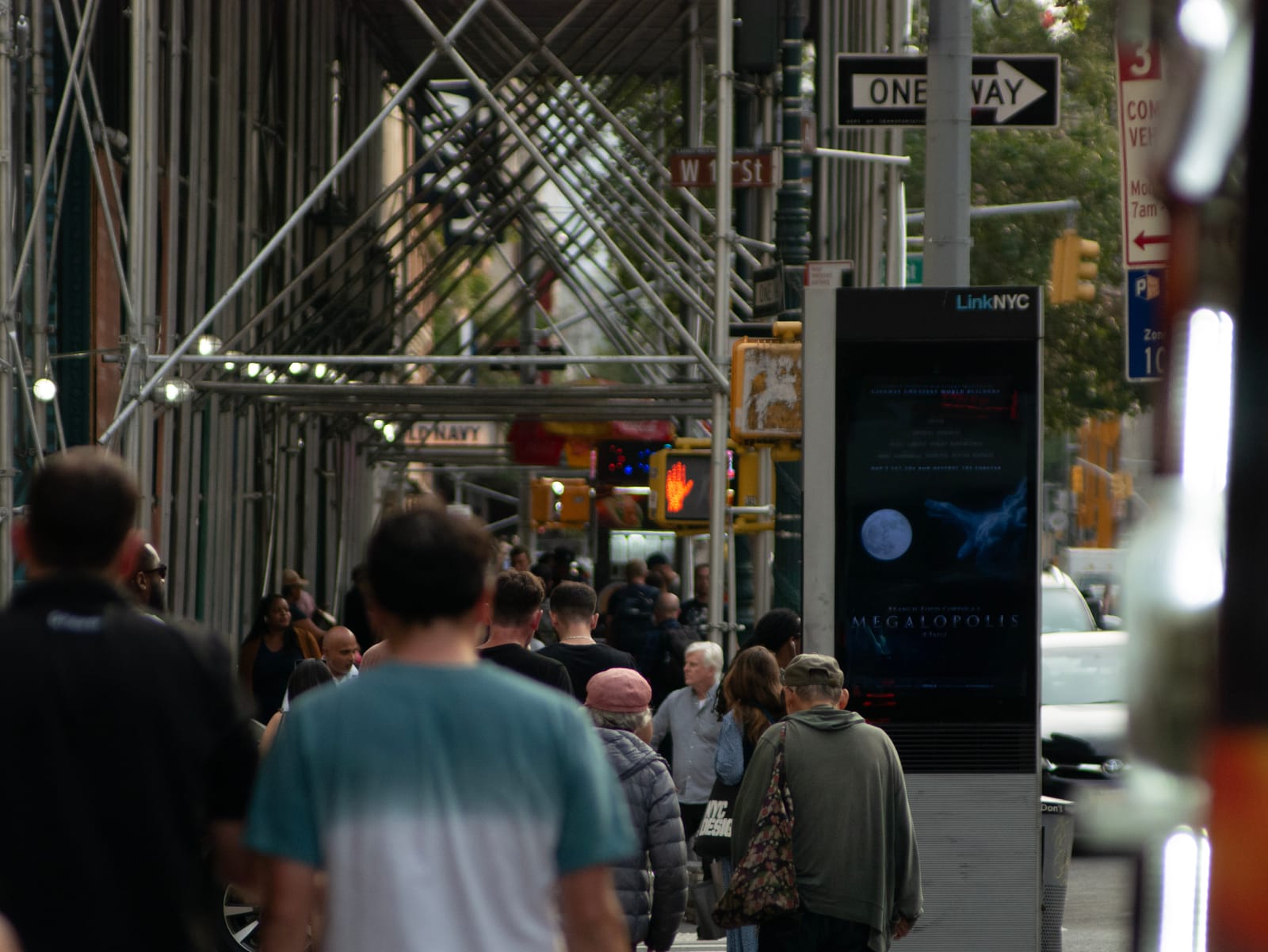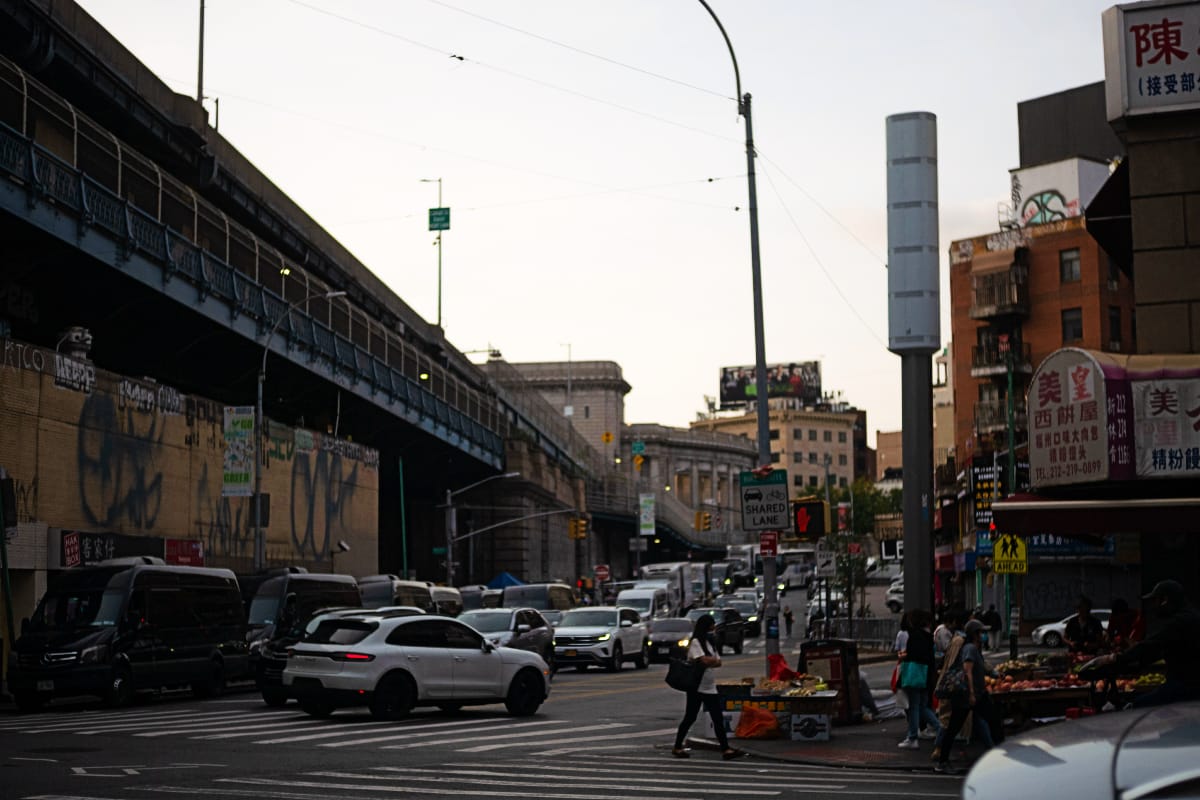What's the Point of LinkNYC?
Expand broadband access? Strengthen 5G networks? Advertising? Eight years later, the kiosks don't fully succeed in doing any of that.
Nick DeMarchis
Published on November 22, 2024 in Hell Gate

Cyber | Originally published at Hell Gate
“Wow, this is really fast.”
That's how a triumphant, not-at-all-staged sizzle reel from 2016 describes LinkNYC's free Wi-Fi, which promised to “take a bite out of the broadband bill for New Yorkers” and help bridge the digital divide.
While ostensibly replacing the City's aging payphone network, the de Blasio–era “innovative” and “sleek” kiosks were slated to connect New Yorkers in more ways than one, pairing Wi-Fi with free calling, USB charging, and gigantic advertising screens. LinkNYC began as an ambitious gamble to add a new component to New York City's streetscape as CityBridge, a consortium of Google spinoff Sidewalk Labs and other partners, announced plans to build 7,500 kiosks and share at least $500 million revenue with the City over the first twelve years.
In the spring of 2016, the monoliths began multiplying throughout Manhattan. But cracks soon appeared. LinkNYC kiosks failed to appear in the outer boroughs at the same pace as Manhattan, and by 2019, CityBridge owed the City nearly $70 million of those revenue-sharing payments.
Stories also soon emerged of people watching porn on the touchscreens, leading CityBridge to turn LinkNYC's built-in web browsers off for good. The kiosks were vandalized with stickers and fractured by bricks. Someone even used the kiosks' speakers to repeatedly play a slowed-down Mister Softee jingle combined with air raid sirens and numbers station–esque rambling.
But LinkNYC has encountered more serious issues, too. That brick-related vandalism incident was how most people discovered that every LinkNYC kiosk has three onboard cameras, their footage retrievable at CityBridge's discretion. The consortium also failed to anonymize user device data for months until an audit unearthed the error. And a student discovered tracking software belonging to CityBridge that, if used on the LinkNYC kiosks, would've likely violated their own privacy policy, not to mention their agreement with the City.
There's a bigger, more existential problem facing LinkNYC, though. Over eight years since the first LinkNYC kiosk appeared on a city sidewalk, the goalposts keep moving for CityBridge. First branded as a payphone replacement and advertising screen network, the de Blasio administration re-envisioned LinkNYC as a way to “bridge the digital divide” and expand Wi-Fi to underserved areas of the city. Then in 2021, CityBridge pivoted to providing infrastructure for cell carriers in the form of 5G towers.
Now, CityBridge is struggling to even meet its newest scaled-down benchmarks. While the City has said they've met their financial obligations this time around (starting at $3 million per year), CityBridge has built just 27 percent of the kiosks it promised to install between July 2020 and 2024, according to the most recently available public data.
And given that you have to be basically within sight of a kiosk (about 100 feet for the original LinkNYCs) to use the (admittedly fast) Wi-Fi, can it really “lift the entire neighborhood and communities that have languished in digital deserts,” as the OTI has said?
All of this raises the question—what is the point of LinkNYC, and why does it still exist?
While conceived during the Bloomberg years, LinkNYC entered the world during the de Blasio era. As the first kiosk blinked online on a chilly morning in 2016, the then-mayor said the program was about “leveling the playing field, providing internet access across the board.” Tech journalists put them to the test and hinted they could be the public Wi-Fi of the future.
At the time, CityBridge's investors included Sidewalk Labs, the controversial Google smart cities spinoff, and Titan, a former New York City payphone franchisee who was caught by Buzzfeed installing Bluetooth trackers in their booths. After a head-spinning number of acquisitions and spinoffs over the last decade, Intersection, the advertising technology company built from the ashes of Sidewalk Labs, appears to be the most prominent voice at CityBridge today.
Adams has inherited the program, which is managed through the City's Office for Technology and Innovation (OTI). And while Adams looked skyward to extol the virtues of the “amazing” towers in July 2022, he's been pretty quiet since.
“Mayor Adams believes affordable internet access is a human right, which is why we are providing more residents with this critical service for free than any other city in the nation,” Ray Legendre, an OTI spokesperson, recently told Hell Gate.
According to CityBridge, users place tens of thousands of calls to City services every year from LinkNYC's free phones (part of what they call a “digital safety net”), and the consortium touts the fact that local businesses and artists can get free ad time on the kiosks' 55-inch displays. In the kiosks' eight-year lifetime, CityBridge says that over 16 million devices have gotten connected to their Wi-Fi.
Nick Colvin, the CEO of LinkNYC, described these benefits as a major success.
“The Wi-Fi service that we provide, the tablet, the free calling—the demand for those has far outstripped expectations,” Colvin told Hell Gate. “So from the perspective of the public good we provide, it's been wildly successful.”
But LinkNYC certainly hasn't had the same success financially. CityBridge, which pays New York City at least a few million dollars per year to run the program, fell behind by nearly $70 million on those payments in 2019. Apparently, running unskippable eye-level ads on kiosks around the City just wasn't cutting it, and the business model “failed,” in CityBridge's words.

In 2021, CityBridge unveiled a new vision to save the program: While advertising on the existing network would remain the primary source of revenue, the new plan would be to build hulking gray 5G cell phone towers in the outer boroughs, and charge cell phone carriers to put their equipment inside. Called Link5G, these towers would also support all the existing features of LinkNYC like Wi-Fi and free calling—except nearly all would lack those iconic advertising screens.
CityBridge wagers that the old equipment will continue to pay for itself, and the new equipment will pay for itself too…eventually.
“The advertising revenue stream is expected to grow, obviously, as time goes by, but that's not primarily going to be driven by the advertising stream deployments,” said Colvin. “What the new small-cell [5G] revenue stream really does is provide the revenue stream to justify the investment in additional structures outside of the core of Manhattan.”
CityBridge probably can't be relying on that revenue anytime soon, though. Gothamist reported in July that literally just two Link5G kiosks of the roughly 200 that are active so far actually broadcast a 5G signal, meaning CityBridge is likely collecting a sliver of the rent they envisioned. Colvin told Hell Gate “that number's not changed yet.” Despite that, CityBridge said one cell phone carrier is under contract to put their equipment in Link5Gs and another is testing to install more.
But let's say more carriers get interested—where could they even go? CityBridge promised to have installed over 1,600 additional kiosks (either the original or 5G version) between July 2020 and 2024. As part of the new agreement with the City, 90 percent of the new Link5Gs need to be installed in the outer boroughs or above 96th Street. (Previously, CityBridge had put about 60 percent of the kiosks in that same area.) As of November 10, they've installed about 450 of them, less than half of which are Link5Gs.
“While it's unfortunate that fewer kiosks have been delivered than promised, the initiative remains a step in the right direction,” City Councilmember Robert Holden, who serves on the committee that oversees LinkNYC, said in a statement. “Expanding connectivity is crucial, and I hope to see progress toward fulfilling the agreement.”
While Link5G lags, carriers have begun building out their newest networks on their own. For example, T-Mobile has already covered over 98 percent of New Yorkers' houses by building out its own network on top of light poles and buildings—and they don't have to pay any rent to CityBridge. Considering Link5G's hardware and carriers' apparent skepticism, an expert who spoke to Gothamist called the new undertaking “kind of pointless, or risky at least.”
CityBridge blames the slow rollout on a variety of factors—waiting on community board, City agency, state, and federal sign-offs; engaging with other local stakeholders like neighborhood and community organizations and politicians (including Jerry Nadler, for some reason); and needing to comply with preservation and environmental regulations.
“Deploying infrastructure in the city of New York is complicated,” Colvin said. “You can't really point the finger at any one thing.”
But even if CityBridge were actually installing all the kiosks they promised, advertising probably wouldn't solve their financial woes, given that nearly all of the 5G towers aren't allowed to sport those iconic moneymaking advertising displays due to their zoning.
Put differently: Until CityBridge can convince carriers to actually put their 5G equipment inside, it's hard to see how they will generate any revenue off the new, blissfully ad-free towers.
In the meantime, New Yorkers are left with “basically a network of digital billboards and some 5G towers that apparently don't even work, that are just too expensive for people to want to pay for,” said Aaron Shapiro, an assistant professor of technology studies at the University of North Carolina at Chapel Hill who has written about the design of the LinkNYC program.
Rethinking the LinkNYC program in 2021 was how CityBridge sought to solve both their financial dilemma and meet the City's demands for digital equity. Assuming they do that, what's in it for them?
Well, at least a little money. In the views of the experts Hell Gate talked to, LinkNYC doesn't need to be about public Wi-Fi, or 5G, or connecting people with 311 and DHS—it could just be a way for CityBridge to collect data, sell ads, and make revenue for the City.
Rick Wilson, a marketing professor at Texas State University who studies advertising on surfaces like the LinkNYC kiosks, said the industry “is doing extremely well,” and generates serious revenue for companies like Intersection. The original kiosks are on prime real estate, in the sightline of countless people daily, so the ad revenue has been reliable—if less than what CityBridge originally expected.
Shapiro believes that's because CityBridge overestimated the amount advertisers would be willing to pay for hyper-targeted ads. They had “spun up a fantasy,” he said, where “they're scraping from your cell phones” to connect seeing an ad to buying something. “And I don't think they were ever going to be able to do that with what they had,” he added.
For instance, Outfront, a competitor to Intersection who's responsible for the ads on subway cars and in subway stations, claims that they can combine larger datasets (for instance, bus location data), information about the ad, and the kind of anonymous ad identifier that Apple cracked down on last year. Together, Outfront can, as the company wrote, splice that data and “mark your device present [to the advertiser] without sharing any personally identifiable information.”

Making that connection, Shapiro said, would be incredibly lucrative if advertisers bought it—especially considering that LinkNYC requires a not-dissimilar amount of information from its users.
And CityBridge has at least experimented. In 2018, a student found publicly available software belonging to LinkNYC that, in his view, “would be able to make advertisements available in real time based on where and who someone was, and that this would constitute a potential violation of the company's privacy policy.” Intersection responded at the time that they were “prototyping and testing some ideas internally, using employee data only,” and that the code was never used on the public LinkNYC network.
Still, CityBridge has worked to convince advertisers of LinkNYC's potential as a lucrative advertising network. The original trademark filing for LinkNYC states that its combination of Wi-Fi, Bluetooth, and third-party data “can all be anonymously overlaid and aggregated to understand real-time, geospatial audience segmentation.” The goal, for them, was to make advertising on the kiosks as seamless and customizable as placing a YouTube pre-roll. And in 2018, one of Intersection's LLCs patented a technology that uses events (like scanning a QR code) on “personal devices” to track “the delivery and performance of digital advertising placed on non-personal devices” using, for example, LinkNYC.
Shapiro was wary of Intersection's approach to advertising on the kiosks.
“It looks a lot less like public infrastructure, and much more like this private, monopolized thing that it actually is,” he said. Shapiro noted that LinkNYC's struggle to provide service in the outer boroughs—the places that Colvin said are “not as remunerative from an advertising perspective”—exposes the program “not as a civic project, but as a financial project.”
CityBridge could be motivated to continue to program just for its possible future uses—whether that's policing or marketing, said Germaine Halegoua, an associate professor of communication and media at the University of Michigan who has written about the “failures of imagination” of LinkNYC since its inception.
“It's like, well, we have the right-of-way, now let's build this infrastructure. Maybe it's not the most useful infrastructure, but it's hardware that we could then use for other sorts of things,” Halegoua said. “I wouldn't be surprised if these things become used for policing, used for increased surveillance of marketing trends...real estate pricing, all of that stuff.”
When asked, Colvin reiterated that “we don't share any data with Intersection, nor do we share it with any of their advertisers.” CityBridge also denies storing any personally identifiable information (like users' emails or browsing history) beyond what's necessary to run the Wi-Fi, as well as sharing it with Intersection—neither of which would be allowed per their agreement with OTI. But for CityBridge's part, LinkNYC's privacy policy hews a bit differently, saying they may “supplement anonymized Technical Information we collect from you with information collected by third parties,” which includes “advertising partners.”
OTI declined to share what data they receive from CityBridge. CityBridge, in turn, said they only share aggregated, anonymous data with OTI, like the average length of a session and amount of data transferred.
Obviously, they could be collecting more than they share with the City regularly. CityBridge has championed, for instance, the most popular phone number called from the kiosks (an EBT hotline) or the most popular Link location (near Times Square). All of that data, LinkNYC's privacy policy states, is “anonymized,” meaning not directly associated with identifiable information like your email address.
But reporting from the New York Times has shown that even “anonymized” data can be both identifiable and lucrative, especially if it can follow people between locations. And CityBridge is less clear about how they treat anonymized data: They only state that they “will not share any information that is not anonymized with any third parties for their own use.”
When asked if it's technically feasible for LinkNYC to do that same kind of cross-location tracking, a spokesperson flatly replied, “No.”
LinkNYC could be a lot worse. After all, the Wi-Fi is genuinely fast (as long as you're close enough to a kiosk), the cameras aren’t rolling 24/7, and they don't track users' browsing activity. But there's a reason NYCLU called LinkNYC a “privacy disaster” last year—namely, we have to take CityBridge at their word when it comes to privacy, as the source code is held in escrow between them and OTI. If CityBridge were to flop, then the City would ultimately own all of LinkNYC's designs and software. Until then, or unless CityBridge were to agree to an independent audit as NYCLU has proposed, the public just won’t know.
In testimony to the City Council Committee on Technology, NYCLU wrote that claims “of anonymization are worth little without full transparency and independent auditing of how they are implemented and how collected data is leveraged for targeting specific audiences.”
To really bridge the digital divide, NYCLU wrote, the City should instead prioritize “a publicly funded and controlled municipal broadband program that ensures every New Yorker, regardless of who they are or how much money they have, can enjoy high-speed, reliable internet access.”
NYCLU also warned about what this program would mean for surveillance systems writ large.
“Sadly, we have all likely become accustomed to the idea that we are surveilled by various companies while we search the internet or use our phones,” the group wrote. “But there is still something uniquely unsettling about a government-approved 'public' project that forces New Yorkers to give up their information whether they use LinkNYC or not.”
Haleguoa framed the future of LinkNYC in terms of why CityBridge made the proposal in the first place. After all, the data that Links could collect is valuable, and “the real pessimist,” Halegoua continued, “would argue it was never about anything but that.”
That pessimist might conclude that LinkNYC “was never about providing anything,” she said, and that “any sort of provision of any sort of common good was a side effect, an externality. And, really, what they wanted to do was get that hardware in to collect data.”
While CityBridge is limited in the data they can share with advertisers, installing hardware all over New York City, she said, “is going to be added value in the future, no matter what you can sell.”